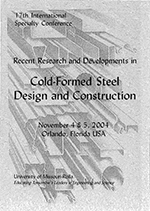Session Dates
26 Oct 2006
Abstract
Laterally braced cold-formed steel beams generally fail due to local or distortional buckling. When the compression flange is not restrained by attachment to sheathing or paneling, such as in negative bending of continuous members (joist, purlins, etc.), members are prone to distortional failures. However, distortional buckling remains a largely unaddressed problem in the main body of the North American Specification (NAS 2001). Only a limited amount of experimental data on unrestricted distortional buckling in bending is available, therefore a new series of distortional buckling tests was completed. The test details are selected specifically to insure that distortional buckling is free to form, but lateral buckling is restricted. Several design methods, including those of the U.S., Canada, Australia, and Europe as well as the Direct Strength Method are compared with the test results. Combined with our previously conducted local buckling tests (Yu and Schafer 2003), we can now provide experimental upper and lower bounds for the capacity of laterally braced cold-formed steel beams in common use in North America. Further, the experimental results have been investigated and extended through the use of non-linear finite element analysis with ABAQUS. This paper covers the setup of the distortional buckling tests, test results, finite element analysis and discussion of current design methods.
Department(s)
Civil, Architectural and Environmental Engineering
Research Center/Lab(s)
Wei-Wen Yu Center for Cold-Formed Steel Structures
Meeting Name
17th International Specialty Conference on Cold-Formed Steel Structures
Publisher
University of Missouri--Rolla
Document Version
Final Version
Rights
© 2006 University of Missouri--Rolla, All rights reserved.
Document Type
Article - Conference proceedings
File Type
text
Language
English
Recommended Citation
Yu, Cheng and Schafer, Benjamin W., "Distortional Buckling Tests on Cold-formed Steel Beams" (2006). CCFSS Proceedings of International Specialty Conference on Cold-Formed Steel Structures (1971 - 2018). 2.
https://scholarsmine.mst.edu/isccss/17iccfss/17iccfss-session1/2
Distortional Buckling Tests on Cold-formed Steel Beams
Laterally braced cold-formed steel beams generally fail due to local or distortional buckling. When the compression flange is not restrained by attachment to sheathing or paneling, such as in negative bending of continuous members (joist, purlins, etc.), members are prone to distortional failures. However, distortional buckling remains a largely unaddressed problem in the main body of the North American Specification (NAS 2001). Only a limited amount of experimental data on unrestricted distortional buckling in bending is available, therefore a new series of distortional buckling tests was completed. The test details are selected specifically to insure that distortional buckling is free to form, but lateral buckling is restricted. Several design methods, including those of the U.S., Canada, Australia, and Europe as well as the Direct Strength Method are compared with the test results. Combined with our previously conducted local buckling tests (Yu and Schafer 2003), we can now provide experimental upper and lower bounds for the capacity of laterally braced cold-formed steel beams in common use in North America. Further, the experimental results have been investigated and extended through the use of non-linear finite element analysis with ABAQUS. This paper covers the setup of the distortional buckling tests, test results, finite element analysis and discussion of current design methods.



